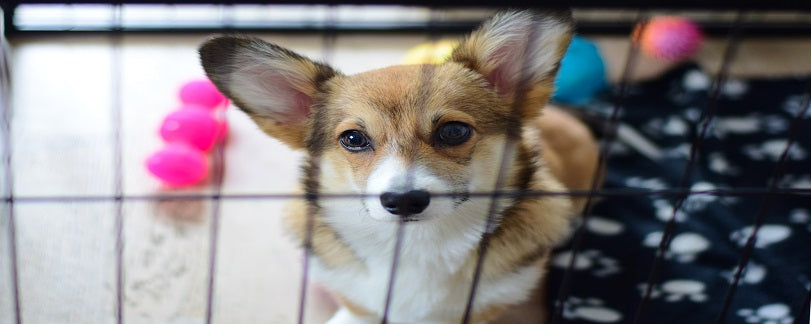
How to Crate Train a Puppy In The UK
Share
Being able to use a crate for your dog can be invaluable. While it may require some effort, in the beginning, to crate train your puppy, you will reap the benefits for many years to come. Training is very important, and the best time to train your puppy is when they are still young. Remember the key elements of training are praise, reward, and consistency.
Understanding Crate Training for Puppies
When you are crate training a puppy, remember that puppies have short attention spans, like toddlers! You must practice the training regularly, if possible a few times a day, but only for a few minutes each time. Your task is to make the puppy see the crate as a safe place to be so that he wants to be there. Do not use it for punishment, or else you will change the association for the puppy.
Choosing the Right Crate
Remember that your puppy will grow, so the crate that seems the right size as a pup, may not be big enough when he is a fully grown dog. You may need to buy a bigger crate as he grows. Your pet will need enough room to stand up and turn around comfortably so that he is not cramped or restricted. Generally, crates are mesh-sided, or plastic. The mesh ones can be collapsed down, which makes them useful for taking your dog to stay in other places.
Introducing the Crate
Put a bed, blanket, and toys inside the puppy crates, so that it is comfortable and inviting. Secure the door open, so your puppy cannot accidentally shut himself inside. See if he will venture in by himself. If he does, reward him with a treat. If he seems reluctant, do not force him, but simply drop a few treats onto his bed to tempt him in.
Creating a Safe and Comfortable Space
Keep rewarding him each time he goes in so that you are constantly reinforcing the message that his crate is a safe space, with lots of treats!
Establishing a Feeding Routine
You can decide to feed your puppy inside his crate, in order to build more positive associations. If you are doing this, make sure that you have room to put the food down, without it spilling over his bed. Including a feeding routine can be very beneficial.
Create a Training Schedule
Make sure that you train your dog consistently. You will soon learn which times of day are best for training your puppy. If he is having a mad 5 minutes, you are unlikely to get him to concentrate, and you run the risk of you both becoming frustrated. A couple of sessions a day teaching him to go into his crate for a reward will give you a good starting foundation.
Using Positive Reinforcement
Positive reinforcement is rewarding the good behaviour. When he goes in his crate and settles, praise him verbally “Good boy!” and with a treat, so that he learns which behaviour you want from him. Dogs are eager to please, and as long as they know what you want from them, they will always do their best.
Dealing with Whining and Crying
Once you have got your puppy happily going in and out of his crate, then you can start shutting the door. This is when you may get some whining and crying. Remember, you can teach anything if you teach it in small sections and break it down. Begin by only shutting the door for a minute, then slowly extend it, then start to move away. If your puppy is whining, wait till he is quiet before you open the door.
Building Independence
Building independence is a matter of steadily increasing the time that you leave your puppy in his crate. If he seems to be struggling, reduce the time again and re-establish the good behaviour, before increasing the time again. In the beginning, even you going out of the room may be distressing to your puppy, so make sure that you keep these moments very short in the beginning so that you can build your puppy's independence up gradually.
Night-Time Training
Night crate training can be problematic. You are not there to monitor your puppy's behaviour, and your puppy may dislike being separated from you. If you are struggling, to speak to a reputable dog trainer or behaviourist. Some people may find using the crate in their bedroom, helps give their pup a feeling of security.
Consistency and Patience
Consistency is the key to all training. Most issues that arise in training a dog are due to inconsistency on the part of the handler. If you are constantly asking for something differently, or changing your level of expectations with no warning, then your dog will not know what you want. Think about how you are giving commands, are you using the same word, the same tone, the same hand gesture? Be patient. Your puppy is learning. When we learn we make mistakes, if you are too harsh on your puppy when he makes a mistake, you will undermine his confidence. Give lots of praise and rewards for the good behaviour. If you are both having a bad day, leave it, and try again tomorrow.
Invest in Your Puppy Today, So You Can Enjoy Tomorrow
When you see someone walking with their dog, with its loose lead and effortless recall, you are seeing the results of hours of training. Having a crate trained dog is incredibly useful. If you are going on holiday, taking your dog to stay with friends or need him somewhere safe for a few hours, being able to pop him in his crate is the ideal solution. Spend the time training him when he is a puppy, you will reap the benefits. Time invested in your pup will give you a delightful canine companion for many years to come.
Give your Puppy a Safe and Secure Kennel
If you are looking for a safe and secure place for your puppy, as an extension to his crate, then an outdoor dog kennel may be the best option. Just as your puppy loves his crate, as his safe place, so too will he love his kennel. Perfect for housing your dog for longer periods of time, an outdoor dog kennel is a fantastic investment for your dog’s life. Take a look at our excellent range of high-quality dog kennels here, our range of dog crates here, or call our friendly team to discuss the best kennel for your dog, on 01942 316 431.
Read related articles:



